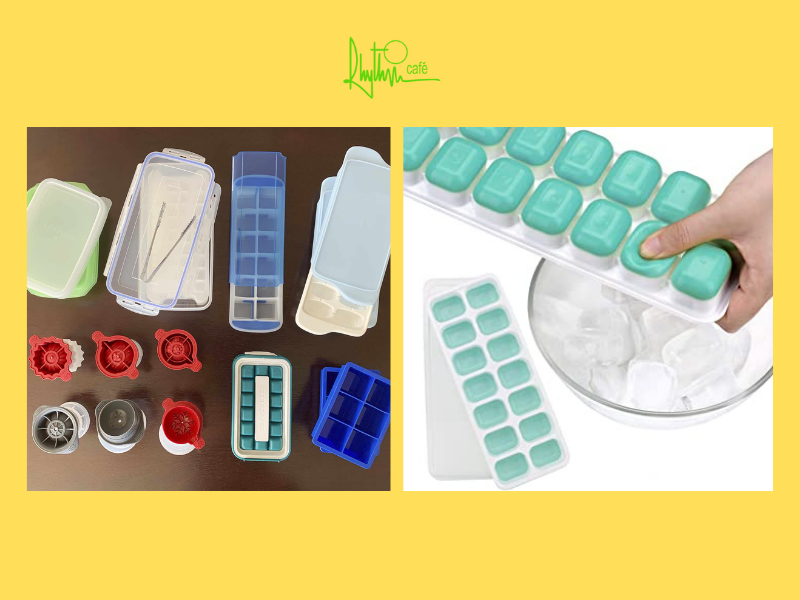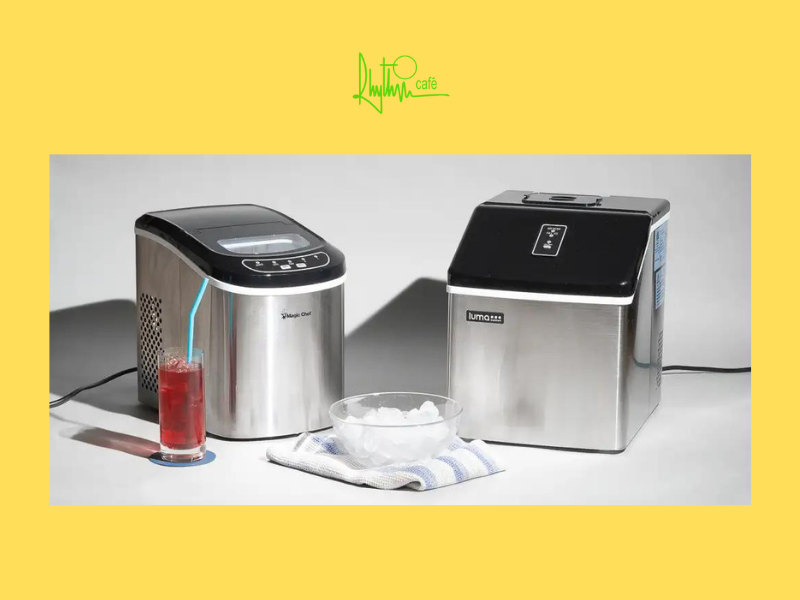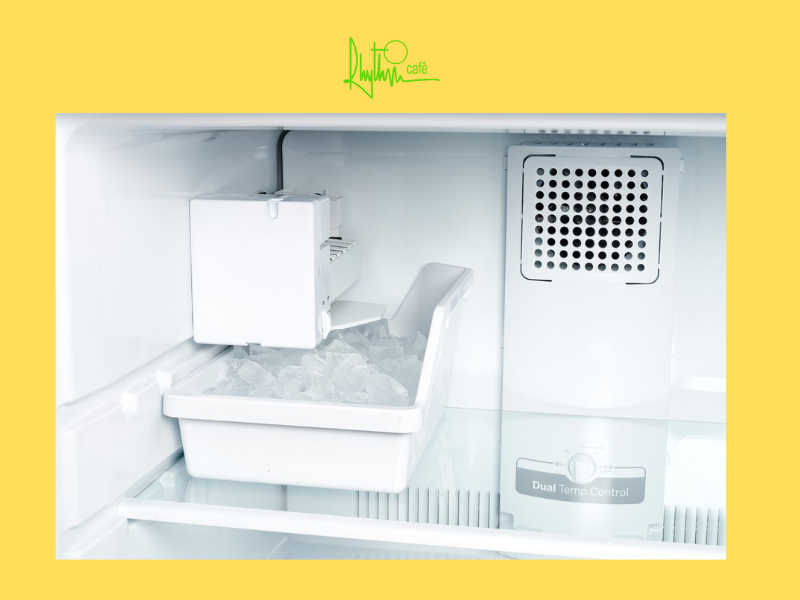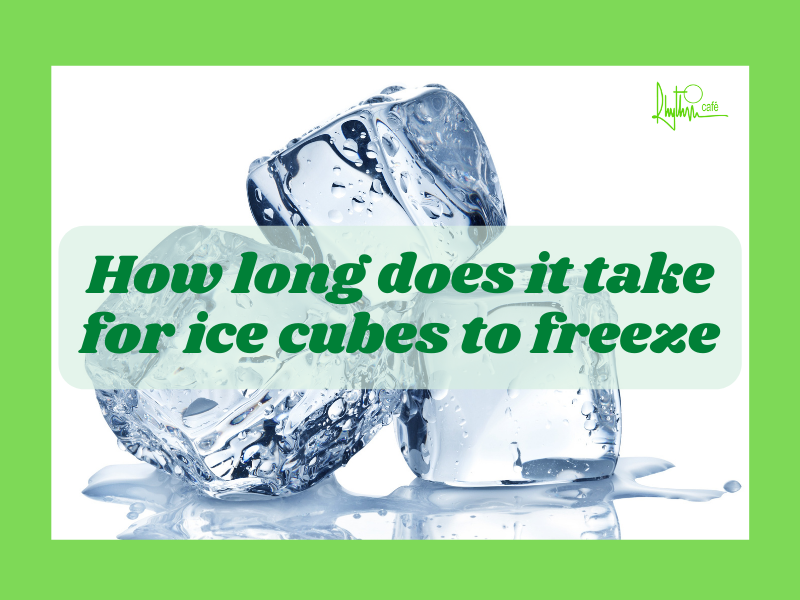Are you ever curious how long does it take for ice cubes to freeze? If so, this blog post is for you! With a handy guide on freezing times and tips on how to make the perfect cubes faster, you’ll have your ice ready in no time. We’ll cover the ideal temperature and conditions needed for rapid cooling and explore what can cause an extended wait. So grab that tray out of the freezer, get your favorite beverage ready, because today we’re going frosty!
To short answer the question: How long does it take for ice cubes to freeze?
In the majority of cases, ice produced in a typical ice tray – those plastic models with space for a dozen tapered cubes – takes about three to four hours to freeze in your home freezer. This can vary depending on the size of your cubes, the temperature of your freezer and a few other factors.
If you have a large tray filled with smaller cubes, they will generally freeze faster than one or two large cubes. Also, if you keep your freezer at a colder temperature, the cubes will freeze faster.
To make sure your ice cubes freeze as quickly as possible, aim to keep the freezer temperature between 0°F (-18°C) and 5°F (-15°C). The higher the temperature, the longer it will take for the cubes to freeze so try not to open your freezer too often. Make sure the cubes are arranged in an even layer, avoiding any overlap between them. This will allow for better airflow and a more efficient freezing process.
9 Factors that affect the freezing process of ice cubes
- Size of the cubes – Smaller cubes freeze faster than larger ones.
- Temperature of the freezer – The colder the temperature, the faster your ice will freeze. Aim to keep it between 0°F (-18°C) and 5°F (-15°C).
- Arrangement in tray – Avoid overlap between cubes and make sure they are laid in an even layer for faster freezing process.
- Type of tray – Using a metal tray or a silicone one can speed up the freezing time significantly compared to using a plastic one.
- Airflow – Poor airflow can lead to slower cooling times so make sure that your cubes aren’t blocked off by something else like food or containers.
- Surface Area of Ice – The more surface area exposed to the cold air, the quicker it will freeze.
- Time of Year – In general, during winter months, your ice cubes will freeze faster as temperatures drop significantly and stay lower for longer periods of time.
- Accompanying Food in the Freezer – If you have other food items in the freezer, it can interfere with the circulation of cold air and slow down the freezing process.
- Amount of water – The more water used in the tray, the longer it will take for your cubes to freeze.
Types of ice cube trays
There are several types of ice cube trays available on the market. Some are made from plastic, while others are made from silicone or metal.

- Plastic ice cube trays usually have multiple sections and often feature a lid which helps keep them sealed and prevent odors or bacteria from entering.
- Silicone ice cube trays are also popular because they can be easily bent or twisted to release the cubes. They are also durable and flexible, so they are less likely to crack when filled with heavy liquids such as hot water.
- Metal ice cube trays can take longer to freeze but they provide a more professional look since they often have a shiny finish. Additionally, metal trays are typically sturdier than their plastic counterparts which makes them less likely to break.
- Stainless steel ice trays are becoming increasingly popular as they are dishwasher safe and highly durable. They also provide an efficient way to chill drinks as the metal quickly conducts heat away from the liquid.
No matter what type of tray you choose, the time it takes for ice cubes to freeze will largely depend on how much liquid is in the tray and how long it has been left out before being put into the freezer.
What is the best ice cube tray?
The best ice cube trays are those made from silicone, as they are more durable and less prone to cracking than their plastic counterparts. Additionally, silicone trays are generally easier to remove cubes from than traditional metal trays. However, the material of the tray may not be as important if you plan on using a chilling device or other methods to speed up the freezing process. Ultimately, it all comes down to personal preference and budget.
All in all, it usually takes about 4-6 hours for standard ice cubes to freeze completely. However, this time can be drastically reduced if you use a chilling device or pre-cooling water before filling up your trays. Additionally, transferring the cubes to a sealed container can help ensure that they stay frozen longer and retain their flavor. Regardless of which method you use, having fresh cubes at hand is always a great way to keep your drinks cool!
How long does it take ice cubes to freeze?
The process of making ice cubes can vary depending on a few factors. Generally, it takes about 3-4 hours for standard size cubes to freeze in your home freezer at the correct temperature. The process could be faster or slower depending on what type of tray you use and other conditions such as air flow, surface area exposed to cold air and time of year.
In silicone ice molds:
Silicone molds freeze the fastest, and can make ice in as little as 15 minutes. The silicone material helps to retain cold temperatures and speeds up the freezing process.
In metal ice trays:
On average, it takes about an hour for metal ice cubes to freeze in a standard refrigerator or freezer. Metal is an excellent conductor of heat which helps it to freeze faster than a plastic tray.
In plastic ice trays:
Plastic ice cube trays typically take the longest – up to four hours or longer in some cases. This is because plastic doesn’t conduct heat as well and can insulate against cold temperatures, slowing down the freezing process.
In stainless steel ice trays:
Stainless steel trays take slightly longer than plastic to freeze, as they retain more heat and don’t insulate against cold temperatures as well. It usually takes about three hours for stainless steel ice cubes to freeze completely.
>> See more:
- How many slices in 16 inch pizza
- How long does Cake last in the fridge
- How long to cook Meatballs at 350
Can you make ice without a freezer?
Yes – you can make ice without a freezer by using an insulated cooler filled with salt and water. The salt will lower the freezing point of the water, allowing it to freeze faster than it would in a standard freezer. You can also add alcohol to the mix, which will further speed up the process. Once your mixture is frozen solid, simply remove the ice cubes from the cooler and enjoy them without worrying about melting.
How to make ice freeze faster?
If you need your ice cubes to freeze faster, there are a few steps you can take.
1- Reduce the temperature of your freezer
The time it takes for your ice cubes to freeze can be influenced by the air temperature in your freezer.
To expedite the freezing process, it’s important to keep the freezer temperature as low as possible. This means that if you’re looking to make ice cubes quickly, consider adjusting the freezer to its lowest temperature setting before filling the ice tray with water and placing it inside.
2- Adjust the size of your ice cubes
If you’re looking to accelerate the freezing process of water, try using smaller ice trays. These trays produce smaller ice cubes that not only freeze quickly, but also add an adorable touch to any beverage.
To obtain these small ice cubes, you may need to purchase specific ice molds that are readily available at most stores.
However, it’s important to note that smaller ice cubes tend to melt faster than larger ones. If you’re looking for ice cubes that melt at a slower pace, consider using an ice tray that is capable of accommodating larger ice cubes.
3- Using boiling water
If you’re looking for a quicker way to freeze cubes, consider using boiling water. Boiling water helps to accelerate the freezing process as it brings down the temperature of the ice tray quickly. This effect on ice cubes is called the Mpemba effect – we’ll explain more below.
This method is best used when filling up a silicone mold as the material will help to retain cold temperatures and speed up the process.
When experimenting with boiling water, make sure to handle the ice tray with caution as it will be very hot.
4- Using ice trays made of different materials
Different materials can have an effect on the freezing process. For example, metal trays tend to freeze faster than plastic trays due to their excellent heat conducting abilities.
So if you’re looking for quick action, consider using a metal tray or a silicone mold.
5- Ensure that everything in your freezer is already frozen
When filling your ice tray, make sure all the items in the freezer are frozen first. This will help to maintain a lower temperature and keep it consistent throughout the entire process, meaning that your cubes will freeze faster.
Extra Tip – Rapidly Chill Water Before Freezing
Another way to quicken the freezing process is by rapidly chilling the water before placing it in the freezer. A good way to do this is by pouring the water into a metal bowl, and then placing that bowl inside a larger bowl filled with crushed ice or a bag of frozen vegetables.
Another similar but more professional way is to use a chilling device. These devices are available on Amazon and operate by utilizing a pre-frozen container of water that features a high surface area space. Once regular-temperature water is poured into this container, the water rapidly chills. The resulting chilled water can then be poured into the ice cube tray, which will significantly reduce the time required for the ice cubes to freeze.
One such product that is available on Amazon is called the “HyperChiller.” This product features a block of ice encased inside a metal container with a very thin volume that creates a large contact area between the ice and the liquid. As a result, the liquid can be chilled to near-zero temperatures within minutes.
Extra Tip – Use Plastic Bags
If you’re in a rush, consider using plastic bags. Place the water in a large Ziploc bag and seal it tightly. Put the bag inside another sealed plastic bag to ensure maximum insulation, then place it in the freezer for 1-2 hours. This should be enough time for the cubes to freeze completely. This method is much faster than using an ice cube tray, but the cubes may not be as uniform or as clear.
Extra Tip – Use a Dedicated Ice Makers
A dedicated ice maker is usually faster than an ordinary ice cube tray. This is because it contains a refrigerator-like compressor system that circulates cold air more rapidly, allowing the water to freeze quickly and evenly. Additionally, some dedicated ice makers can produce up to 50 pounds of cubes in 24 hours which makes them ideal for large gatherings or special occasions.

How long does it take for ice cubes to freeze with a dedicated ice maker? Generally, it takes about 30 minutes or less for the ice cubes to freeze completely, depending on the size and shape of your particular tray. Some are even capable of making ice on demand. However, this method is best used only if you need your cubes quickly as it will add extra stress on your energy bills.
Extra Tip – Refrigerator Ice Maker Setting
Most refrigerators come with an ice maker setting, which will automatically produce a batch of cubes every few hours. The exact time it takes for the cubes to freeze depends on your model and the water temperature, but typically ranges from 1-4 hours.

A refrigerator ice maker will usually be faster than an ordinary ice cube tray when it comes to making and freezing cubes. This is because the refrigerant in the machine circulates cold air more rapidly, allowing the water to freeze quickly and evenly. However, some newer ice makers can take up to 24 hours to completely fill the bin with ice cubes. Therefore, if you need ice in a hurry it is best to use an ice cube tray or special molds that are designed to produce slow-melting ice cubes.
The Mpemba Effect – Hot water freeze faster!
You may have heard of the Mpemba Effect [1], a phenomenon in which hot water freezes faster than cold water (reduce your freeze time by at least 15%).
The Mpemba Effect occurs when hot water cools down faster than cold water due to the increased evaporation of warmer temperatures. As the molecules in hot water move more quickly, they create a higher level of energy which causes them to evaporate more quickly. This reduces the overall temperature of the liquid and thus speeds up freezing time.
How to make ice cubes from hot water?
The Mpemba Effect can be seen when using boiling water, but it is important to note that you should never put boiling water directly into the ice cube tray. Instead, fill up a container with the hot water and wait for it to cool down to room temperature or slightly above before pouring it into the tray. This will ensure that the cubes freeze properly and don’t crack.
How long does ice stay frozen?
On average, it takes around two hours for ice cubes to freeze in an ice tray. However, this time can vary depending on the material used to make the tray and if any additional methods are employed (such as pre-cooling water). Once frozen, the cubes should stay frozen for a few weeks, although their quality may diminish over time due to air exposure.
To keep your cubes fresh and frozen for longer, consider transferring them into a freezer bag or other hermetically-sealed container after they have frozen. This will help protect them against the drying effects of air and keep their texture intact.
How to keep ice frozen longer?
If you want to keep your ice cubes frozen for longer, try using a single-use plastic bag or a hermetically-sealed container. This will help prevent the cubes from drying out and losing their texture over time. Additionally, avoid placing them directly in direct sunlight as this will cause them to melt quickly. Lastly, consider adding some salt to the water before freezing it. This will reduce the temperature at which the cubes begin to melt and keep them colder for longer.
How to keep ice frozen longer when outdoors?
If you plan to take your cubes outdoors for a picnic or camping trip, consider pre-cooling the ice tray before adding the water. This can help reduce the overall freezing time and keep the cubes from melting too quickly once they’re outside. Additionally, make sure to pack your cubes in an insulated container with plenty of thick layers of insulation material to keep them frozen for longer. This will help you enjoy your ice cubes long after the party is over!
Is it possible to use something other than water to make ice cubes?
Yes – you can use other liquids and even certain types of purees in order to create unique-flavored ice cubes. Some examples include fruit juice, herbal teas, or even puréed fruits and vegetables. However, it is important to note that some items may require a longer freezing time due to their higher sugar content. Example:
- Fruit juice ice cube: Fill the ice cube tray halfway with your desired fruit juice. Place it in the freezer for 4-6 hours or until the juice has frozen into cubes. The resulting cubes should have a sweet, fruity flavor and provide a refreshing treat on hot summer days.
- Herbal teas ice cube: Fill the ice cube tray halfway with your favorite herbal tea. Place it in the freezer for 4-6 hours or until the tea has frozen into cubes. The resulting cubes should have a light, delicate flavor and make an excellent addition to drinks or desserts.
- Puréed fruits/vegetables ice cube: Fill the ice cube tray halfway with your desired puréed fruit or vegetable. Place it in the freezer for 4-6 hours or until the purée has frozen into cubes. The resulting cubes should have a unique flavor and be a great addition to smoothies and other creative dishes.
- Coffee ice cube: Fill the ice cube tray halfway with cold coffee. Place it in the freezer for 8-12 hours or until the coffee has frozen into cubes. The resulting cubes should have a strong, bold flavor and provide an interesting twist to iced coffee drinks.
Be sure to check the instructions on the tray before pouring in any liquids. Regardless, creating unique and flavorful ice cubes can be a great way to add a twist to your favorite drinks!
>> See more:
- How long is Rotisserie Chicken good for in the fridge
- How long can Cooked Bacon sit out
- How long to Microwave a Hot Pocket
FAQs about How long does it take for ice to freeze
How much water impacts ice cube freezing time?
The amount of water in your ice cubes can have a major impact on their freezing time. Generally speaking, the more water you add to the mixture, the longer it will take for the cubes to freeze. Additionally, if there is too much water in your ice tray, it can cause them to freeze together and make it difficult to remove individual cubes. For the best results, aim to fill your ice trays with just enough water so that each cube is filled without overflowing. This will help ensure that they freeze quickly and evenly.
Does an Empty or Full Freezer Matter?
Yes – the amount of time it takes for ice to freeze can vary depending on whether the freezer is empty or full. An empty freezer will generally freeze items faster than a full one, as there is less air within it for the heat to move around.
Do Different Liquids Take Different Amounts of Time?
Yes – different liquids can take different amounts of time to freeze. Water usually takes the least amount of time, while heavier liquids such as juice and puréed fruits/vegetables may take a bit longer due to their higher sugar content.
What is the Best Temperature for Freezing Ice?
The best temperature for freezing ice is 0°F (-18°C), as this is the temperature where water becomes a solid. However, some liquids may require slightly lower temperatures in order to freeze properly.
Can You Reuse Ice?
Yes – you can reuse ice cubes that have been frozen provided that they are still solid and intact. To ensure safety, be sure to discard any cubes that have become crumbly or appear to have melted and re-frozen. This will help prevent bacteria and other contaminants from entering your drinks.
How ice forms and freezes?
Ice forms when water molecules slow down and get close enough to form a crystal lattice structure. This usually happens when temperatures drop below 32°F (0°C). At this point, the water molecules lock together in an organized pattern and transform into ice. As the temperature continues to decrease, the ice crystals grow larger until they form solid cubes. The time it takes for ice to freeze can vary depending on the size of the cubes, the temperature of the freezer, and the amount of air present in the freezer. However, most ice cubes should be ready in 4-6 hours or less.
Is a Refrigerator Ice Maker Faster?
Yes – a refrigerator ice maker is designed to make and freeze ice cubes much faster than an ordinary freezer. This is because the refrigerant in the machine circulates cold air more rapidly, allowing the water to freeze quickly and evenly. However, it should be noted that some newer ice makers can take up to 24 hours to completely fill the bin with ice cubes.
Can You Freeze Water in 5 Minutes?
No – freezing water in 5 minutes is not possible as the process takes significantly longer. Depending on the size of your ice cubes and the temperature of your freezer, it can take anywhere from 4-12 hours for water to freeze into solid cubes. However, you can speed up the process by adding salt or alcohol to the water before freezing it.
Can Ice Freeze in 30 Minutes?
No – ice will usually take longer than 30 minutes to freeze. Depending on the size of your cubes, the temperature of your freezer, and the amount of air in your freezer, it can take anywhere from 4-12 hours for water to freeze into solid cubes.
How can I get ice without melting?
If you need ice without melting, the best method is to use a standard freezer. This will allow your ice cubes to freeze slowly and evenly, resulting in strong, solid cubes that stay frozen for longer periods of time. Additionally, some freezers are equipped with an “Ice Maker” feature which can produce ice quickly but may not be as resilient as the ones produced in a standard freezer. You can also add salt or alcohol to the water before freezing it, which will help speed up the process while still creating strong ice cubes. Finally, you can purchase special molds that are designed to produce slow-melting ice cubes.
Can ice freeze in 2 hours?
Yes – ice can freeze in as little as 2 hours depending on the size of your cubes, the temperature of your freezer, and the amount of air present in the freezer. However, it is important to note that larger cubes will take longer to freeze than smaller cubes. It is also recommended to check on the cubes after 1 hour and every 30 minutes thereafter to ensure that they are freezing properly. Additionally, adding salt or alcohol to the water can help speed up the freezing process.
What is the temperature of ice when it freezes?
The temperature of ice in a freezer typically ranges from 15°F (-9°C) to 32°F (0°C). However, the actual temperature can vary depending on the size and shape of your cubes and the temperature set for your freezer. Additionally, some freezers are equipped with an Ice Maker feature which can freeze water faster than a standard freezer. In this case, the temperature of the ice cubes can be much lower than 15°F (-9°C).
How long do ice blocks take to freeze?
Ice blocks usually take longer to freeze than ice cubes due to their shape and size. On average, it will take between 6-12 hours for an ice block to be completely frozen. However, this time can vary depending on the temperature of your freezer, the amount of air in the freezer, and how much water is in the block.
How can I fit an ice maker in my kitchen?
An ice maker is a convenient appliance that can be easily incorporated into any kitchen. There are several types of ice makers available on the market, ranging from large commercial models to smaller freestanding units ideal for small kitchens.
Before purchasing an ice maker, it’s important to measure your space and make sure it will fit properly in the location you plan to install it. Additionally, make sure that the model you choose is compatible with your home’s power supply and plumbing connections. Finally, be sure to read the instruction manual carefully before using the ice maker for the first time. With proper installation and usage, an ice maker can provide a steady supply of chilled cubes without taking up too much space in your kitchen.
Conclusion
The answer to the question “How long does it take for ice cubes to freeze” depends on various factors, such as temperature, materials used, and how quickly you can cool down the water before pouring it into the tray. On average, it should take anywhere between 1-2 hours for ice cubes to freeze in a regular tray. However, with the right techniques and tools, you can greatly reduce this time. After they have frozen, it is recommended that you transfer them into a freezer bag or other hermetically-sealed container to keep them fresh and frozen for longer.
To speed up the process, consider using metal trays or silicone molds, ensuring that everything in your freezer is already frozen, or rapidly chilling the water before freezing it. You can also use an ice maker machine if you need some icy treats in a hurry. And, don’t forget to take advantage of the Mpemba Effect by using hot water instead of cold! Get freezing!

Leslie Fowler is the founder of Rhythm Cafe, a barbecue restaurant with over 15 years of experience. Leslie is an exceptional pitmaster and grill expert, specializing in smoking briskets and pork shoulders on charcoal, wood, or propane grills/smokers. Leslie has also tried out almost every model of kitchen appliance available on the market, making her an authority on grills and smokers.

